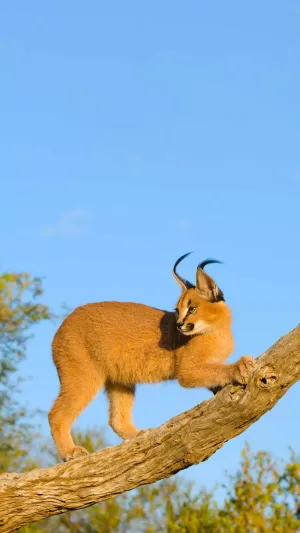Caracals are found in most of Africa, the Arabian and Anatolian peninsulas, Kazakhstan, and central India. Caracals are a very territorial felines and the heaviest and fastest of all small cats.
Caracals are picky eaters, discarding the guts and fur of mammals they catch. They are also easily domesticated and kept as pets. Wild caracals live an average of 12 years.
Caracals also have long black hairs on the tips of their black ears, which look like antennae. It is this feature that can be mistaken for a lynx. But in fact, they are quite different from the lynx, which can be distinguished by looking at them.
The back of the ears of caracal cats is basically black, the color of the head and body is relatively simple, and there are a few black stripes on the face, which looks more like a cat.
The lynx has white hair on the back of the ears, leopard-style fur on the head and body, and long white hair on the chin. The face looks more like a tiger.
Caracals were once considered close relatives of lynxes because of the pair of antennae on the tips of their ears.
But later, through genetic research, it was found that the caracal is not closely related to the lynx, but is more closely related to the serval and the African golden cat. All three cats belong to the caracal lineage.
Caracals are best known for their long, thick black ears. Caracals also have a wide range of habitats, inhabiting steppes, and semi-deserts, but also woodlands, savannas, shrubs, and even mountains at an altitude of 3,000 meters.
Like other felines that live in arid regions, caracals can survive long periods of time without water. At this time, they mainly rely on the body fluids in the prey to obtain water.
Caracals hunt rodents and hares at night (but also during the day in cooler seasons). But they even occasionally attack gazelles, small antelopes, or young ostriches.
Caracals are picky eaters, discarding the guts of mammals they catch, partially plucking hyraxes and larger prey, and removing flesh from their skin to avoid hair.
Caracals are best known for their birding skills. Caracals can catch birds in flight, sometimes more than two at a time. The caracal can jump up to a height of 4 meters, which is equivalent to the height of two and a half adults stacked together, which is amazing.
The caracal's speed and agility are also very strong. As long as the prey is no more than 5 meters away from the caracal, the caracal can quickly launch a fatal attack on the prey.
In Africa, caracals often compete for food with foxes, wolves, leopards, and ferocious hyenas. Leaving aside the rest, just daring to deal with animals as hyenas have already shown the caracal's excellent fighting ability.
The chances of seeing caracals in the wild are very, very small, not because they are very rare, but because they are well hidden. Many other animals can be encountered in countries such as Kenya and Botswana, but the chances of seeing a caracal are very rare.
Because caracals are easily domesticated by humans, they were once used as hunting cats in the Middle East and India. Caracals are now bred as pets (especially in the US) and are said to be easily adapted to living with humans.
The caracal is often regarded as a pest by farmers in Africa because it often climbs over fences and preys on chickens and other poultry. The caracal has been included in the IUCN Red List of Least Concerned Species.





